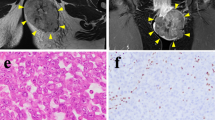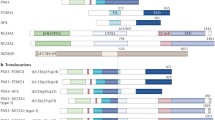Abstract
Spindle-cell/sclerosing rhabdomyosarcoma (ssRMS) is a rare subtype of rhabdomyosarcoma, characterized by unique pathological features. Although distinctive molecular backgrounds such as frequent mutations in MyoD1 have been reported, optimized therapy has not been fully developed, and further investigations are required. Patient-derived cancer models are critical tools for basic and pre-clinical studies. However, there is no model for ssRMS. Thus, this study aimed to develop a novel cell line from the tumor tissue of a patient with ssRMS. Using surgically resected tissue, we successfully established this cell line, named NCC-ssRMS1-C1. These cells exhibited spindle-shape morphology, consistent with the pathological observations of the original tumor tissue. Genetic studies demonstrated that NCC-ssRMS1-C1 cells retained original copy number alterations and the typical point mutation in MyoD1. Malignant phenotypes such as proliferation, spheroid formation, and invasion were confirmed in vitro by studying NCC-ssRMS1-C1 cells. Upon screening an anti-cancer agent library, sensitivity to conventional chemotherapeutic agents such as actinomycin D was revealed. We conclude that the NCC-ssRMS1-C1 cell line will be a useful resource for basic and pre-clinical studies.





Similar content being viewed by others
References
Rudzinski ER, Anderson JR, Hawkins DS, Skapek SX, Parham DM, Teot LA. The world health organization classification of skeletal muscle tumors in pediatric rhabdomyosarcoma: a report from the children's oncology group. Arch Pathol Lab Med. 2015;139:1281–7.
Cavazzana AO, Schmidt D, Ninfo V, et al. Spindle cell rhabdomyosarcoma. A prognostically favorable variant of rhabdomyosarcoma. Am J Surg Pathol. 1992;16:229–35.
Mentzel T, Katenkamp D. Sclerosing, pseudovascular rhabdomyosarcoma in adults. Clinicopathological and immunohistochemical analysis of three cases. Virchows Arch. 2000;436:305–11.
Folpe AL, McKenney JK, Bridge JA, Weiss SW. Sclerosing rhabdomyosarcoma in adults: report of four cases of a hyalinizing, matrix-rich variant of rhabdomyosarcoma that may be confused with osteosarcoma, chondrosarcoma, or angiosarcoma. Am J Surg Pathol. 2002;26:1175–83.
Wang J, Tu X, Sheng W. Sclerosing rhabdomyosarcoma: a clinicopathologic and immunohistochemical study of five cases. Am J Clin Pathol. 2008;129:410–5.
Bouron-Dal Soglio D, Rougemont AL, Absi R, et al. SNP genotyping of a sclerosing rhabdomyosarcoma: reveals highly aneuploid profile and a specific MDM2/HMGA2 amplification. Hum Pathol. 2009;40:1347–52.
Kuhnen C, Herter P, Leuschner I, et al. Sclerosing pseudovascular rhabdomyosarcoma—immunohistochemical, ultrastructural, and genetic findings indicating a distinct subtype of rhabdomyosarcoma. Virchows Arch. 2006;449:572–8.
Zhao Z, Yin Y, Zhang J, et al. Spindle cell/sclerosing rhabdomyosarcoma: case series from a single institution emphasizing morphology, immunohistochemistry and follow-up. Int J Clin Exp Pathol. 2015;8:13814–20.
Yasui N, Yoshida A, Kawamoto H, Yonemori K, Hosono A, Kawai A. Clinicopathologic analysis of spindle cell/sclerosing rhabdomyosarcoma. Pediatr Blood Cancer. 2015;62:1011–6.
Sultan I, Qaddoumi I, Yaser S, Rodriguez-Galindo C, Ferrari A. Comparing adult and pediatric rhabdomyosarcoma in the surveillance, epidemiology and end results program, 1973 to 2005: an analysis of 2,600 patients. J Clin Oncol. 2009;27:3391–7.
Ghandi M, Huang FW, Jane-Valbuena J, et al. Next-generation characterization of the cancer cell line encyclopedia. Nature. 2019;569:503–8.
Bairoch A. The cellosaurus, a cell-line knowledge resource. J Biomol Tech JBT. 2018;29:25–38.
Fletcher CDM, Bridge JA, Hogendoorn P, Mertens F. WHO classification of tumours of soft tissue and bone. 4th ed. Geneva: WHO Press; 2013.
Hawkins DS, Chi YY, Anderson JR, et al. Addition of vincristine and irinotecan to vincristine, dactinomycin, and cyclophosphamide does not improve outcome for intermediate-risk rhabdomyosarcoma: a report from the children's oncology group. J Clin Oncol. 2018;36:2770–7.
Yoshimatsu Y, Noguchi R, Tsuchiya R, et al. Establishment and characterization of NCC-CDS2-C1: a novel patient-derived cell line of CIC-DUX4 sarcoma. Hum Cell. 2020;33:427–36.
Agaram NP, LaQuaglia MP, Alaggio R, et al. MYOD1-mutant spindle cell and sclerosing rhabdomyosarcoma: an aggressive subtype irrespective of age. A reappraisal for molecular classification and risk stratification. Mod Pathol. 2019;32:27–36.
Acknowledgements
We thank Drs. F Nakatani, E Kobayashi, S Fukushima, M Nakagawa, T Komatsubara, M Saito, C Sato (Department of Musculoskeletal Oncology, National Cancer Center Hospital), T Shibayama, and H Tanaka (Department of Diagnostic Pathology), for sampling tumor tissue specimens from surgically resected materials. We would like to thank Editage (www.editage.jp) for their assistance with English-language editing and their constructive comments regarding the manuscript. This research was financially supported by the National Cancer Center Research and Development Fund (Grant Nos. 29-A-2) and technically assisted by the Fundamental Innovative Oncology Core in the National Cancer Center.
Author information
Authors and Affiliations
Contributions
YY and TK designed the study, and wrote the manuscript. RN, RT, and AS contributed to the experiments and interpretation of data, and assisted in the preparation of the manuscript. JS, SI, MS, AY, and AK have contributed to clinical samples and data collection, and the preparation of manuscript. AY contributed to the pathological diagnosis, and the preparation of manuscript. All authors critically reviewed the manuscript, approved the final version of the manuscript, and agree to be accountable for all aspects of the work in ensuring that questions related the accuracy or integrity of any part of the work are appropriately investigated and resolved.
Corresponding author
Ethics declarations
Conflict of interest
The authors declare that they have no conflict of interest.
Research involving human participants
The use of clinical materials for this study was approved by the ethical committee of the National Cancer Center (2004-050).
Informed consent
The written informed consent was obtained from the donor patient.
Additional information
Publisher's Note
Springer Nature remains neutral with regard to jurisdictional claims in published maps and institutional affiliations.
Electronic supplementary material
Below is the link to the electronic supplementary material.
Rights and permissions
About this article
Cite this article
Yoshimatsu, Y., Noguchi, R., Tsuchiya, R. et al. Establishment and characterization of NCC-ssRMS1-C1: a novel patient-derived spindle-cell/sclerosing rhabdomyosarcoma cell line. Human Cell 33, 886–893 (2020). https://doi.org/10.1007/s13577-020-00359-1
Received:
Accepted:
Published:
Issue Date:
DOI: https://doi.org/10.1007/s13577-020-00359-1




